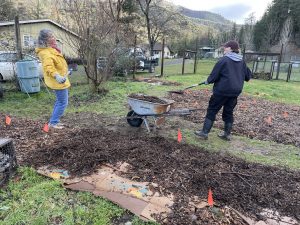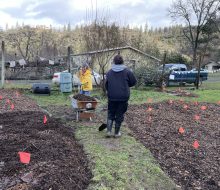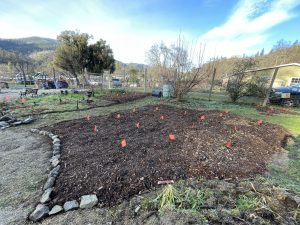Sanctuary One’s Earth Care Manager, Jess Mealy, recently has had pollinators on her mind; plants with names that sound plucked straight from a fantasy novel.
It’s because she has been hard at work getting them planted, 44 butterfly and bee pull-offs, including Oregon Sunshine and Pearly Everlasting, that are now in the ground in Sanctuary One’s Healing & Learning Garden. By spring to early summer, an opus of color should be in full bloom.
“That’s what’s really fun for me, I think,” Mealy says. “I really like to think about colors that go well together.”
It’s all thanks to the 55-acre Applegate care farm’s recent partnership with the Xerces Society for Invertebrate Conservation, an international nonprofit dedicated to protecting the winged creatures that help plants grow. It’s named for the Xerces blue butterfly, declared extinct in the 1940s due to development in San Francisco, according to their website, xerces.org.
“The Xerces Society is a science-based conservation organization, working with diverse partners that include scientists, land managers, educators, policymakers farmers, and communities,” the site says.
And now, Sanctuary One is part of it. Janelle Whitfield, the care farm’s Program Manager, submitted a proposal to the group after finding out about them through the Jackson County Master Gardeners Program she is part of.
“They sent out an email offering habitat kits, that contained certain pollinator-friendly wildflowers and shrubs at no cost to Oregon farmers and community partners,” Whitfield said. “This program will help us better serve the community and our school field trips in sharing important information about the state of our pollinator population here in Oregon and educate people how to preserve and help our pollinators to survive and continue to grow in population.”
Mealy and Sanctuary One volunteers put the pollinator plants they received from the Xerces Society in a 450-square foot garden area at the farm toward the end of 2023. There is a zone for plants that are purple, pink, and blue (including Showy Milkweed and Douglas Aster), and another for plants that are yellow and white (Oregon Sunshine, Pearly Everlasting, Yarrow and Canada Goldenrod.)

One of our volunteers, Christina, and our intern, Merica, working on sheet mulching for the Xerces project plants.
“It’s always nice to see that in bloom,” Mealy says of the Goldenrod. “And the bees love it.”
It’s an experience, she adds, that informed her knowledge about native plants.
According to the Center for Pollinator Research, more than 80% of plants use pollinators to reproduce, and more than 75% of the world’s major food crops benefit from pollinators. One out of three bites of food you eat is thanks to them.
The endeavor to be part of their preservation effort fits perfectly into Sanctuary One’s three-pronged mission, focused on people, animals, and the earth. Pollinators benefit all three.



